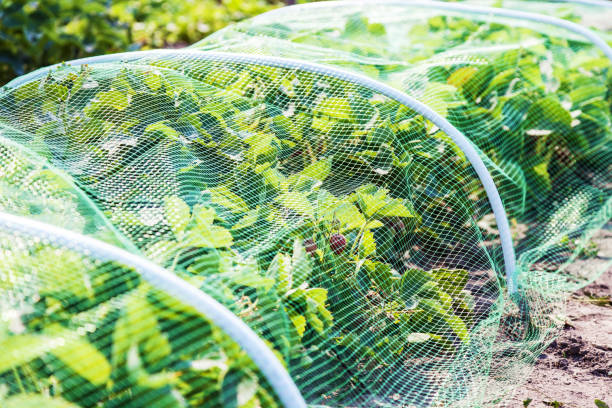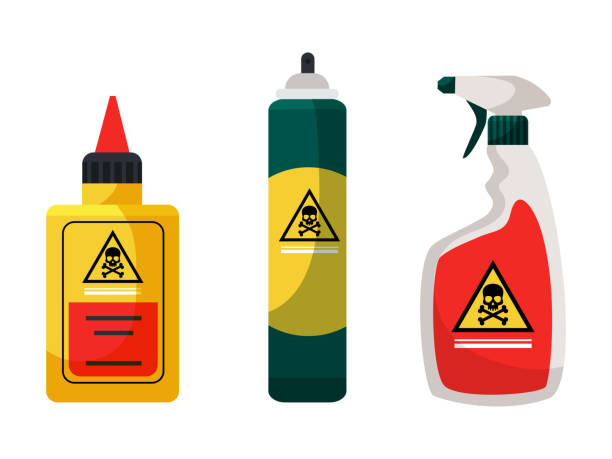Thrips are tiny, soft-bodied insects with over 6,000 known species, many of which cause significant harm to plants. These pests often feed on specific plants and are frequently named after their preferred hosts, such as:
- onion thrips
- pea thrips
- gladiolus thrips
- rose thrips, etc.
Thrips are cigar-shaped and incredibly small, measuring about 1/25 of an inch in length. Their colors range from brown, black, and yellow, with some species featuring distinct colored markings. These insects have narrow, fringed wings but are poor fliers, relying on crawling or being carried by the wind. Nymphs, the juvenile stage of thrips, resemble adults but are even smaller and lack wings.
Understanding what thrips are and how they operate is the first step in protecting our plants from their harmful effects.
Now, let’s explore the practical steps we can take to get rid of thrips and keep our plants safe.
How We Can Get Rid of Thrips on Plants
Here’s what has worked effectively for us:
1. Prune Affected Areas

Start by removing any infested branches, leaves, or stems. Carefully cut away the damaged parts with pruning scissors and dispose of them in the trash—not the compost pile. Pruning helps stop thrips from spreading further across your plants.
2. Spray with Water

Use a garden hose or spray bottle to dislodge thrips from your plants. Pay extra attention to the undersides of leaves, as that’s where these pests like to hide.
3. Make Your Own Insecticidal Soap
For indoor and outdoor plants, insecticidal soap works wonders. You can either buy a commercial option or mix your own. Combine 1 tablespoon of mild liquid soap (like Castile or Ivory) with 1 quart of water, and spray it directly on the affected areas. Be sure to reapply as needed to disrupt their life cycle.
4. Apply Diatomaceous Earth

Diatomaceous earth is a natural, powdery substance made from fossilized remains of tiny aquatic organisms called diatoms. It’s safe for humans and pets when using food-grade versions, but it’s lethal to many pests.
Sprinkle it on the plants and the soil surrounding them. The tiny, sharp particles cut through the thrips’ outer layer and absorb their moisture, which ultimately kills them. This method works particularly well on larvae that fall to the ground.
Be sure to reapply after watering or rain, as the powder loses effectiveness when wet.
5. Attract Natural Predators

Lacewings, ladybugs, parasitic wasps, predatory mites, and nematodes are some of the best allies in keeping thrips under control. You can buy these predators online or plant flowers that attract them, like dill and marigolds.
6. Reflect Light

If you’re managing plants outside of greenhouse kits, consider using reflective mulch, plastic, or mesh around your plants. The glare confuses thrips and makes it harder for them to locate their host plants.
7. Avoid Chemical Pesticides

Skip chemical insecticides. Thrips quickly build resistance to them, rendering them ineffective. Worse, these chemicals often harm beneficial insects that help keep your plants healthy.
How to Keep Thrips Away for Good
Here’s what we’ve found most effective:
1. Inspect New Plants Before Bringing Them Home
Always check newly purchased plants carefully. Look for signs of pests, like discolored leaves or dark specks, before introducing them to your garden or home. For extra precaution, isolate new plants for a couple of weeks to ensure they aren’t harboring thrips or other pests.
2. Keep Plants Healthy
Healthy plants are more resilient against pests like thrips. Regular watering, proper sunlight, and balanced fertilization go a long way in keeping plants strong and less attractive to these invaders.
3. Clean Up Garden Debris
Remove weeds, fallen leaves, and other debris from your garden regularly. Thrips often hide in plant litter near vulnerable plants, so keeping the area clean reduces their hiding spots and breeding grounds.
4. Use Companion Plants to Repel Thrips
Strategically plant natural repellents like garlic, basil, and oregano near more vulnerable plants. These companion plants help deter thrips while adding variety to your garden.
5. Avoid Over-Fertilizing
Thrips are drawn to tender new growth, which can result from excessive fertilization. Stick to recommended fertilizer amounts to avoid creating a feast for these pests.
6. Treat Bulbs Before Planting
If you’re planting gladiolus or other bulbs, take extra steps to protect them. Soak bulbs in a solution of 1 tablespoon of Lysol mixed with 1 gallon of water for several hours before planting. If you’re storing bulbs over winter, keep them at 35–40°F to kill any lingering thrips, but make sure they don’t freeze.
How to Spot Thrips on Plants Before They Take Over
Detecting thrips early is crucial to stopping them before they cause serious damage. Here’s how you can spot these tiny pests:
Step #1. Look for Insect Movement

Disturb the plant by gently shaking the leaves or stems. Thrips often leap or flutter away when disturbed, but since they’re poor fliers, they won’t travel far. Their movement is one of the clearest signs of their presence.
Step #2. Use the White Paper Method
Hold a piece of white paper under an affected branch and give it a gentle shake. Thrips will fall onto the paper, where you can see them more easily against the bright background. For a closer look, use a magnifier to examine the dislodged insects.
Step #3. Spot Their Waste

Thrips leave behind tiny black specks of waste, sometimes referred to as “thrips poop.” If you notice this alongside wrinkled, stippled, or discolored leaves, there’s a good chance you’re dealing with thrips.
Step #4. Inspect New Growth
These pests prefer tender, fresh growth. Check the newest leaves, stems, and buds for any signs of thrips activity or damage.
Step #5. Set Up Sticky Traps

Place sticky traps near your plants to catch and monitor thrips. Blue traps are especially effective since they’re more attractive to thrips than the standard yellow ones.
Protecting Plants Thrips Love
Thrips tend to target specific types of plants, so understanding which ones are most vulnerable can help us protect them better. Here’s what you need to know:
Safeguard Your Houseplants
Thrips can attack nearly any houseplant but are particularly drawn to those with broad, thin leaves. Popular houseplants like alocasia, calathea, monstera, peace lily, ZZ plant, dracaena, palms, and dieffenbachia are at higher risk. To protect these plants:
- Regularly inspect leaves, especially the undersides.
- Keep new plants quarantined for a few weeks before adding them to your collection.
- Use sticky traps to monitor pest activity indoors.
Give Extra Care to Outdoor Plant
Thrips are notorious for targeting certain crops and flowers:
- Farm Crops: Plants like tomatoes, strawberries, cucumbers, onions, peppers, and citrus are frequent targets. Regularly check leaves and stems for early signs of damage, such as streaking or discoloration.
- Flowers: Thrips seem particularly drawn to flowers in shades of white, yellow, or blue, such as roses, pansies, gladiolus, marigolds, and chrysanthemums. Keep these plants healthy by pruning damaged areas and using preventative measures like companion planting.
Protect Your Shrubs and Woody Ornamentals
Trees and shrubs such as azalea, hibiscus, dogwood, magnolia, and rhododendron are also susceptible to thrips. Focus on cleaning up plant debris around these plants and maintaining their overall health to reduce the likelihood of infestations.
Keep Bonsai Thrip-Free
Bonsai trees, with their intricate foliage and detailed care needs, are also at risk of thrips infestations. These pests can cause significant damage if left unchecked. To protect bonsai:
- Inspect leaves and branches regularly, focusing on crevices and the undersides of leaves.
- Use a gentle spray of water to dislodge thrips without harming the tree.
- Apply insecticidal soap carefully, ensuring it won’t damage the delicate leaves. Test a small area before wider use.
- Keep the area around the bonsai clean and refresh the topsoil periodically to reduce hiding spots for pests.
Take Action to Protect Your Plants
Thrips may be small, but their impact on plants can be significant if left unchecked. Now that you know how to identify, eliminate, and prevent these pests, it’s time to put these strategies into action.
Don’t wait for an infestation to take hold—proactive care is the key to healthy, thriving plants.






0 Comments